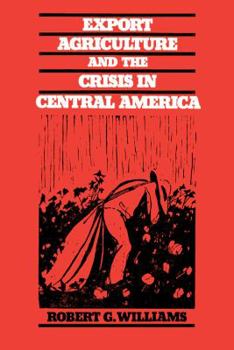Export Agriculture and the Crisis in Central America
Select Format
Select Condition 
Book Overview
Before social unrest shook the region in the 1970s, Central America experienced more than a decade of rapid export growth by adding cotton and beef to the traditional coffee and bananas. Williams... This description may be from another edition of this product.
Format:Paperback
Language:English
ISBN:0807841544
ISBN13:9780807841549
Release Date:May 1986
Publisher:University of North Carolina Press
Length:273 Pages
Weight:0.90 lbs.
Dimensions:0.6" x 6.0" x 9.0"
Customer Reviews
2 ratings
University of California anthropologist, Carol A. Smith, reviews Williams' work
Published by Thriftbooks.com User , 18 years ago
University of California anthropologist, Carol A. Smith, reviews Williams' work in the International Encyclopedia of the Social and Behavioral Sciences, "What took place in Central America calls for comparative research. The most useful and original comparisons have been done by Robert Williams, an economist who uses sociological, historical, and ethnographic methods in his research. Robert Williams's Export Agriculture (1986) observes that cotton and cattle production for export expanded hugely in all five countries and led to significant dispossession of peasants everywhere, including Costa Rica. But the five Central American states handled peasant protest quite differently, with both Costa Rica and Honduras carrying out land reform and expanding services while the three other states responded with repression and militarization-which led to war. In States and Social Evolution (1994), Williams examines the social and economic factors that led to two different kinds of states in Central America-the three revolutionary countries being controlled by rigid oligarchies, the other two being led by more open political groups. (Williams) finds an explanation in the social and political relations created by the coffee export economy, the first major post-colonial export in the region, which played a critical role in state formation."
The environmental repercussions of export agriculture
Published by Thriftbooks.com User , 22 years ago
Williams' book deals with the issue of export agriculture in Central America and its repercussions on the economic, ecological, and social well-being of this troubled region. Williams divides the book into three parts, according to the main exports of Latin America. First, Williams deals with cotton's emergence as a cash crop and its positive and negative aspects. Second, Williams deals with cattle and the effects it has had upon the land and the men who till it. This book is interesting in the way it views the cash crops in an economic light and in the ways they affect farmers, large farmers, and the working class. The environment has blessed Central America with some of the best land anywhere on earth. Central America's pacific coastal plain, for example, is ideal for growing cotton. The ecological consequences of growing cotton, however, are quite severe. The stress on the soil is severe, considering this crop is not for subsistence. While the law requires that the land be cleared as to protect the land, it is nearly inevitable to prevent the volcanic soils to be vulnerable from wind and water erosion. In the rainy season, however, thunderstorms take their toll on the soil since they make the land prone to flooding. This damage is in addition to the fact that the best lands are used for the production of cotton, while simultaneously polluting the coastal eco-system. The fertility of the soil was short lived in Central America, since after four or five years of consecutive cultivation the light soils of the coastal plain began to lose their natural fertility. This, in turn, led to the need to use chemicals to yield more crops per acre of land. In regards to cattle, Williams argues that the emerging demand for beef in the United States as a result of the fast food business precipitated the need to make subsistence plots in Latin America land for cattle grazing. For institutions like the World Bank, AID and IADB cattle was seen as a pragmatic, quick way to achieve export led growth. By most accounts, this land was carved from Central American forests. Swidden agriculture (slash and burn) practiced by indigenous allowed for the land to be regenerated after the patch had been abandoned. Under modern methods of forest clearing, the land is almost always relegated to remaining fallow. Modern methods of clearing have allowed for flatlands below the grazing grounds to become subject to flooding. Williams concludes that for those privileged enough to gain access to bank credit, the beef export boom meant a quick way to expand their fortunes, while for those who planted for survival it spelled impending doom.





